Introduction
A handful of flax, chia, and hemp seeds are all powerhouses of nutritional benefit providing essential Vitamins and minerals, and essential omega fatty acids. These seeds provide many nutrients together without consuming different foods to acquire many health benefits, and they can be simply added to a fruit bowl or a salad. The only seed that needs to be ground to release its nutrients is flax seeds since pre-ground flax seeds is not recommended for consumption because once they are ground they oxidise within hours so they might do more harm than good to the body. In this article I want to discuss nutritional value of these 3 seeds specifically, the omega fatty acids and discuss how essential they are to human health. We will use the diagram depicting Eicosanoids which we have seen in previous articles :
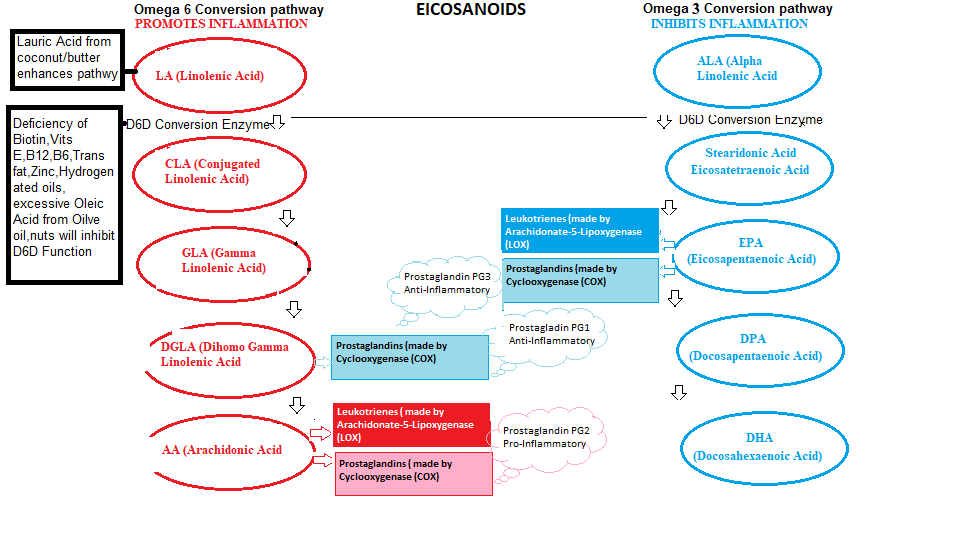
Why do we need essential fatty acids

If you want to think of inflammation in a non medical sense, when the body is under attack from a foreign entity or substance the body lights up the body like a localised fire ( unless the assault is systemic then you have a raging fire in multiple areas), NOT TO DO DAMAGE, but to signal the ‘police department’ ( the immune system pro-inflammatory unit) to engage a defense force to apprehend the invasion. Once the threat has been dealt with, it’s time for the body’s ‘Fire department’ ( immune system’s anti-inflammatory unit) to go into action to put the fire out and effect repairs from the damage. Of course these events are played out biologically and electrochemically using a series of signalling cascades by complex proteins. In order to build these signalling proteins the body uses fatty acids such as essential fats which are referred to as Omega 3, omega 6 fatty acids whose origins come from Alpha Linolenic Acid (ALA), and Linolenic Acid ( LA) respectively. Once these acids are absorbed by the body it can get to work on manufacturing the crucial signalling required to activate the police and fire department. If an individual is deficient in these vital fatty acids then the fire in the body gets out of control causing unrepaired damage and eventual deterioration igniting chronic conditions throughout. The manufacturing plant for these essential signalling molecules is shown in the diagram above called ‘Eicosanoids’.
Eicosanoids
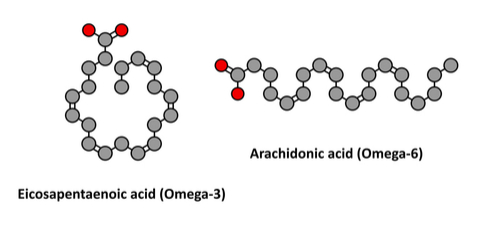
Eicosanoids are essentially signalling molecules made enzymatically or by non enzymatic oxidation from Arachidonic acid or other fatty acids like PUFA (Polyunsaturated fatty acids ) allowing cells to communicate between each other especially during an inflammatory response. These signalling molecules are Prostaglandins, Leukotrienes, thromboxanes.
Prostaglandins
Hormones, which are regulatory substances used to stimulate specific cells or tissues to function, are released from various organs that are Endocrine derived ( specific organ to a distant part of the body) system. Whereas prostaglandins behave in a similar manner but they are Autocrine/Paracrine derived ( acting on itself/acting within the vicinity or localised ) also involved within an inflammatory response scenario. The Prostaglandins are transient insofar as they are metabolised rapidly. Referring to the diagram above, it shows the Prostaglandins Series 1 (PG1) derived from DGLA, Series 2 (PG2) derived from AA and Series 3 (PG3) derived from EPA. The fatty acid Base dietary sources are LA ( Linoleic Acid for Omega 6 ) found primarily in plant grain oil, nuts and ALA ( Alpha Linoleic Acid for Omega 3) found in plant seed oil and vegetables and some nuts. A third category is Conjugated Linoleic Acid (CLA) which is found naturally in grass fed beef and grass fed dairy. CLA is also produced in the body by bacterial conversion of LA.
Prostaglandin series 1,2 and 3
PG2 series of Prostaglandins are involved in inflammation response promotion by recruiting Mast cell and Macrophage cells to treat injury and effect repair. It also regulates the human reproduction system by inducing labor. PG3 and PG1 series Prostaglandins are anti-inflammatory messengers that are responsible for protecting the body from heart attack and also acting as mediators for inflammatory responses, so one part of the Omega 6 Conversion pathway promotes inflammation ( as it has to repair the body ). The other part of the Omega 6 pathway producing PG1 and the Omega 3 Conversion Pathway producing PG3 dampens inflammation (once repair is complete ). PG3s provide an anti-clotting function, lowering of triglycerides ( fats in the blood), blood pressure control and the improvement of skin conditions. Therefore there are 2 anti-inflammatory pathways and 1 proinflammatory pathway. You will notice also from the diagram certain nutrient deficiencies actually inhibit both pathways production. Another observation is the recommended 2:1 ratio which is necessary since if you swing to far in either direction ( typical ratio for people eating fast food or processed food could by 15 or 20:1) would continuously saturate the conversion enzymes and leave nothing to manufacture Omega 3 products, unless you consumed enough fish oil and/or fish eggs. In effect you have necessary opposing systems ( an ‘On’ and ‘Off’ switch ) synonymous to the ANS Sympathetic ( On switch ) and the Parasympathetic (Off switch ).
Immune system mediators: Leukotrienes
Leukotrienes are divided into 2 functional groups. The first group are involved where neutrophils, an essential inflammation site first responder and an essential cell of the innate immune system are utilized Physiological dysfunction triggers the production of Leukotrienes, activating an inflammatory process such as Cystic Fibrosis, Inflammatory Bowel Disease and Psoriasis ( the latter two are autoimmune conditions). The second group are involved where basophils, and mast immune system cells, trigger an allergic inflammatory response igniting bronchial conditions such as Asthma.
Consuming essential dietary fatty acids

Consuming enough of omega 3 essential fatty acids ( such as flax, hemp or chia seeds, fatty fish, krill oil) and too much omega 6 fatty acids ( such as butter, animal fats, organ meats, coconut and eggs) prostaglandin and leukotriene production is disrupted due to the imbalance. The deficiency of Biotin ( eggs), and Vitamins E, B12, excessive consumption of hydrogenated oils ((Vegetable oils like soy and corn ), margarine that contains trans fat, or Oleic acid ( from Olive oil), and even excessive nut consumption will inhibit the D6D (Delta 6 Desaturase) conversion enzymes. This is important if you rely on the multi-step conversion process to produce the essential immune system messenger molecules Leukotrienes and Prostaglandins. Unfortunately, biological conversion processes vary from person to person and aging is another factor that determines its efficiency. Assuming the conversion is inefficient our gut bacteria produce Conjugated Linolenic acid which gives the host another chance to produce these inflammatory messengers, but if the gut is dysbiotic as we focused on during our discussion of autoimmune conditions, then this will not work either causing vital repair work not to be accomplished within the body. Science informs us that the conversion of ALA to EPA as shown in the diagram above is poor in humans, so it is recommended to consume foods that already contain EPA or DHA, such as fatty fish. If it is indeed a fact that this conversion is poor and you don’t consume foods containing EPA/DHA then your fire department is understaffed and inefficient in putting out the inflammatory fire, so it is wise to eat wild fish at least twice/week., even a can of sardines which is much cheaper than wild caught salmon is better than nothing.
The science of Omega fatty acids

As you can appreciate from our eicosanoids diagram above the object is to maintain control of inflammatory action and keep the fire under control by balancing the necessary inflammatory response with its regulatory mechanism of the omega 3 anti-inflammatories. It is always written in articles involving omega fatty acids that a healthy ratio of 1,2 or 3: 1 ( omega 6 : omega 3) should be respected, although some of the more recent science dispute the importance of this ratio. However, logically speaking if the balance is 15-25: 1, as witnessed by individuals following a western diet then it means that less anti-inflammatory omega 3 based signalling molecules are produced and more pro-inflammatory omega 6 signalling molecules are produced which means the fire is out of control, and inflammation is winning. From my perspective, to maintain at least a 4:1 ratio as did our hunter gatherer ancestors maintained, it makes more sense in terms of biological balance. Omega 3 PUFAs are defined by the number of carbon atoms and double bonds, so ALA contains 18 carbons and 3 double bonds so it is designated C18:3n-3, EPA is designated C20: 5-3, and DHA C22::6n3. The Omega 6 PUFAs include Linoleic acid which has a carbon-carbon double bond ( 6 carbons away from the methyl end of the fatty acid chain so it is designated C18: 2n-6 and Arachidonic acid is C20:4n-6. Something else that I am sure you are burning to know..lol, that the human can only form carbon-carbon double bonds after the 9th carbon from the methyl end of the fatty acid chain which is why LA and ALA are essential because they cannot be made within the body.
Polyunsaturated fats (PUFA) are key structural and functional components of cellular membrane phospholipids, so during a pro-inflammatory response the cell membranes contain a high proportion of Arachidonic acid and much less EPA or DHA. By introducing more dietary EPA or DHA it reduces the amount of arachidonic acid thus ‘dousing’ the fire and thus reducing inflammation, Furthermore, the COX and LOX gene expression balances in favor of a more anti-inflammatory environment. Both COX ( Cyclooxygenase) and LOX (Lipoxygenase) enzymes produce pro and anti-inflammatory prostaglandin/leukotriene signalling so balance here is critical between a fire out of control and a fire under control. The dietary use of Turmeric has beens studied and proven to regulate the synthesis of these enzymatic processes since the active ingredient curcumin is an anti-inflammatory that regulates both LOX and COX signalling pathways as described in the study ‘Regulation of COX and LOX by Curcumin by Rao CV in 2007 published by PubMed.
Plant sources of the omega fatty acids

As you can see from the seed charts below, all 3 seed profiles contain the essential omega fatty acids. These seeds also contain vitamin E and B6 which are necessary for these omega pathways. Biotin you can get from egg consumption and B12 from fish or nutritional yeast if you are a vegetarian.
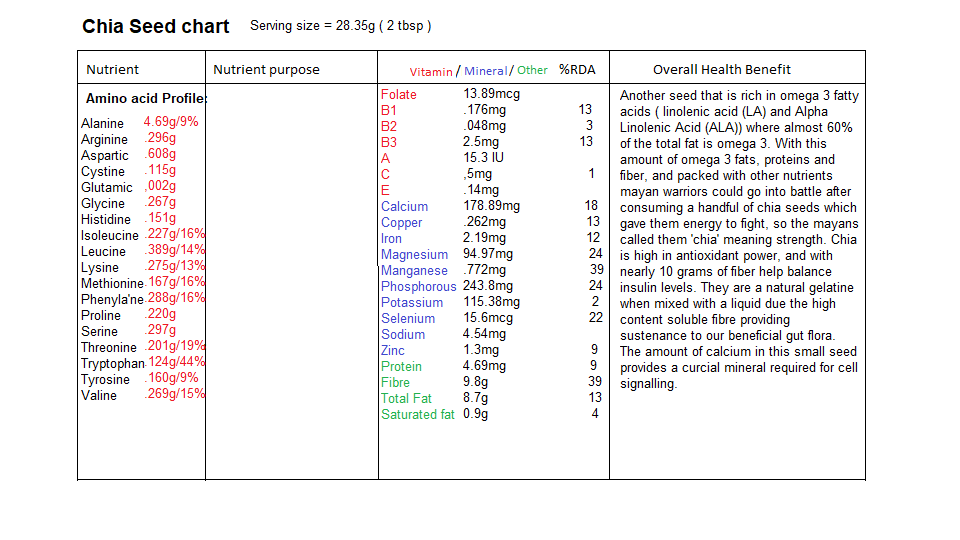
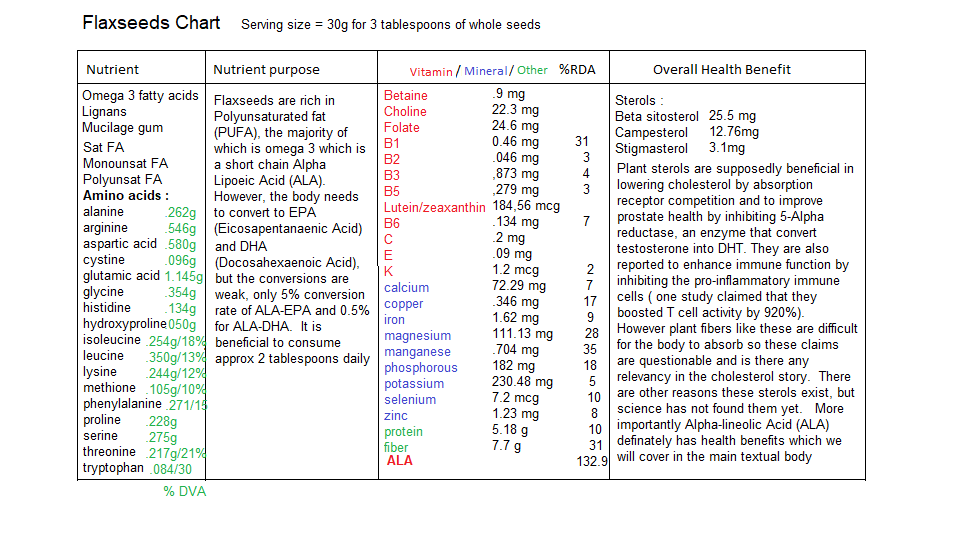
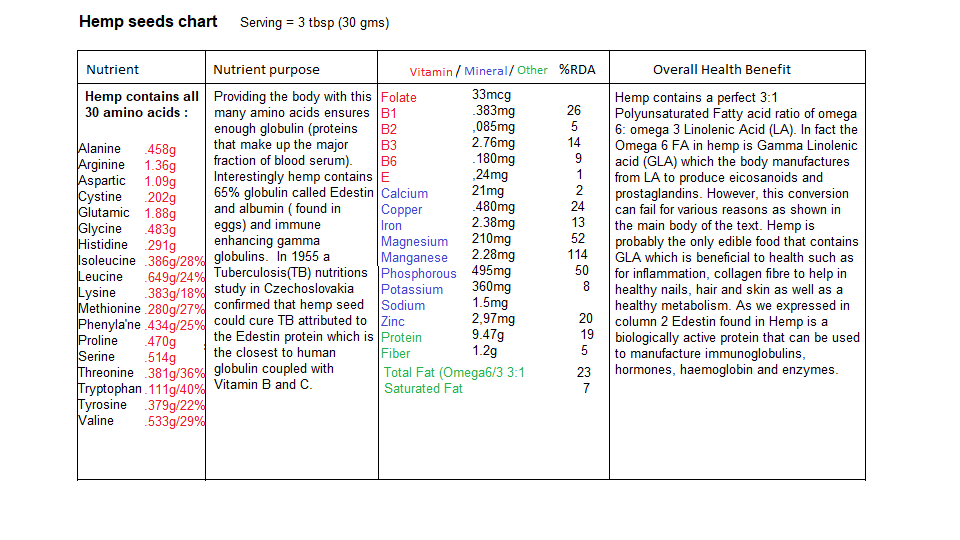
How much omega fatty acids do I need
As I have stated before I don’t think we really know specifically, there exists only ‘guesstimates’ such as an adult should consume 250-500 mg of EPA/DHA/day. Where did this come from ? As we stated before, conversion of EPA/DHA from ALA which is performed in the liver is only at best, 15% efficient, so it is preferable to consume it from dietary means. Fish contains EPA/DHA which accumulates in their tissue from the consumption of microalgae. A particular species of microalgae called Haematococcus pluvialis that overtime have developed a sunscreening method to protect themselves from UV radiation. This natural sunscreen is called Astaxanthin* which is a keto carotenoid that marine crustaceans like Krill, eat this algae, are harvested for its oil and a philippines fermented krill dish called ‘Bagoong’. Astaxanthin gives the krill a red color as in Salmon, lobster and shrimps who eat the krill and is a powerful carotenoid antioxidant. DHA is particularly high in the retina of the eye, the brain and sperm. It is universally recognised that increasing EPA/DHA blood levels is as important if not more so than balancing the LA/ALA ratio.
*If you want to protect your skin from normal ( 2 hours max between 10am-3pm) sun exposure it would not hurt to take a Krill oil capsule once a day during the summer, and it will also provide an amount of EPA/DHA in addition as mentioned in the next paragraph
Harris and Von Schacky in their findings from epidemiological studies and randomised controlled trials demonstrated an Omega Index depicting an inverse association with the risk of mortality from coronary heart disease where 8% on the index was protective, but 4% was a higher risk value. To maintain the body in the 8% range is to consume 4-500mg of EPA/DHA daily by eating fatty fish like salmon, pickled herring, tuna bluefin. Sea bass, king crab,walleye or flatfish or even sardines or tuna in a can. So the recommended intake for ALA/day is 1.6g ( male ) and 1.1g (female) from 18 years on. To put this into perspective 1 ounce of chia seeds = 2 tablespoons as in the chia chart above provides 5.06 grams of ALA, 1 tablespoon of whole flax seeds provides 2.35 grams of ALA. Three ounces of Salmon provide approximately 1.23 grams DHA, and 0.50 grams EPA. A can of sardines provides approx 0.74 g DHA, and 0.45 g EPA. A krill oil supplement one 500 mg softgel tablet will deliver 120 mg EPA, and 75 mg DHA, and 750 mg astaxanthin. If you are wondering about fish oils, Krill oil is more stable in terms of potential rancidity. Because the fatty acids in Krill oil are in Phospholipid form, while fish oil are in triglyceride form, some studies show that absorption is better with Krill oil by measuring EPA/DHA plasma levels over a period of 72 hours which were higher from Krill oil takers versus fish oil takers.
Conclusions
It is clear that the consumption of both LA (Omega 6) / ALA (Omega 3), and EPA/DHA is essential for health. How you achieve this in your diet is up to the individual. From my perspective consuming wild or organic salmon at least twice/week, or a can of sardines 2-3 times/week will provide enough EPA/DHA and consuming some plant omega 3 fatty acids from chia and/or flaxseeds and/or hemp seeds will provide enough ALA. Adding coconut oil to your diet will provide enough LA since it contains 0.245g of PUFA/tablespoon.
Check out other Articles in this series:
Nutrients in Food and their bodily purpose I (Phenols)
Nutrients in Food and their bodily purpose II (Lignans, Triterpenes, Phytosterols, Carotenoids & Fats)
Nutrients in Food and their bodily purpose III (Phenolic acids, sulphur, sulphides,sulphoxides )
Nutrients in Food and their bodily purpose IV (Glucosinolates, Sulforaphane, Indole-3-Carbinol)
Nutrients in Food and their bodily purpose V (Lipid distribution, absorbed fats, Criciferous Veg)
Nutrients in Food and their bodily purpose VI (Nutrients required for Liver Detox)
Nutrients in Food and their bodily purpose VIII (Nutrients required for cellular energy production)
Nutrients in Food and their bodily purpose IX (Water I Properties and Body fluids)
Nutrients in Food and their bodily purpose X (Water II Cellular Hydration)
Nutrients in Food and their bodily purpose XI (Water III Fluid filtration, reabsorption, excretion)
Nutrients in Food and their bodily purpose XII (Water IV Blood pressure, Blood volume regulation)
Nutrients in Food and their bodily purpose XIII (Water V Body Fluid Dysfunction
Nutrients in Food and their bodily purpose XIV (Dental Nutrients)
Nutrients in Food and their bodily purpose XV (Nutrients involved in Methylation I)
Nutrients in Food and their bodily purpose XVI (Nutrients involved in Methylation II)
Nutrients in Food and their bodily purpose XVII (Nutrients involved in Methylation III)
Nutrients in Food and their bodily purpose XVIII (Nutrients involved in Methylation IV)
Nutrients in Food and their bodily purpose XIX (Methylation V and the Microbiota I)
Nutrients in Food and their bodily purpose XX (Methylation VI and the Microbiota II)
Nutrients in Food and their bodily purpose XXI (Superfoods: Wheatgrass)
Nutrients in Food and their bodily purpose XXII (Superfoods: Adaptogens)
Nutrients in Food and their bodily purpose XXIII (A look into our nutritional past Sir Robert McCarrison)
Nutrients in Food and their bodily purpose XXIV (Pregnancy: Nature vs Nurture vs Nutrition)
References/Acknowledgments :
- Chia/hemp/flax seeds nutritional value and analysis Nutritionvalue.org
- Gamma Linolenic acid (GLA), Edestin, Wikipedia
- Forbidden Medicine:Hemp seeds treat Tuberculosis naturalsociety.com
- Czechoslovakia Tubercular Nutritional study 1955 Google scholar
- Benefits of plant sterols Dr Whitaker
- Autoimmune disease IV(Inflammatory mediators) article extremehealthacademy.com
- Regulation of COX and LOX by Curcumin Rao CV 2007 NCBI
- The omega 3 Index Axel Sigurdsson 2015 Doc’s Opinion
- Omega 3 Fatty acids National Institutes of Health
- Krill oil vs Fish oil. Which is better for you ? Healthline
- Omega 3 Polyunsaturated fatty acids and inflammatory processes: nutrition or Pharmacology Philip Calder 2013 BJCP NCBI
- AZ Quotes: Quote on Omega 3
Author: Eric Malouin